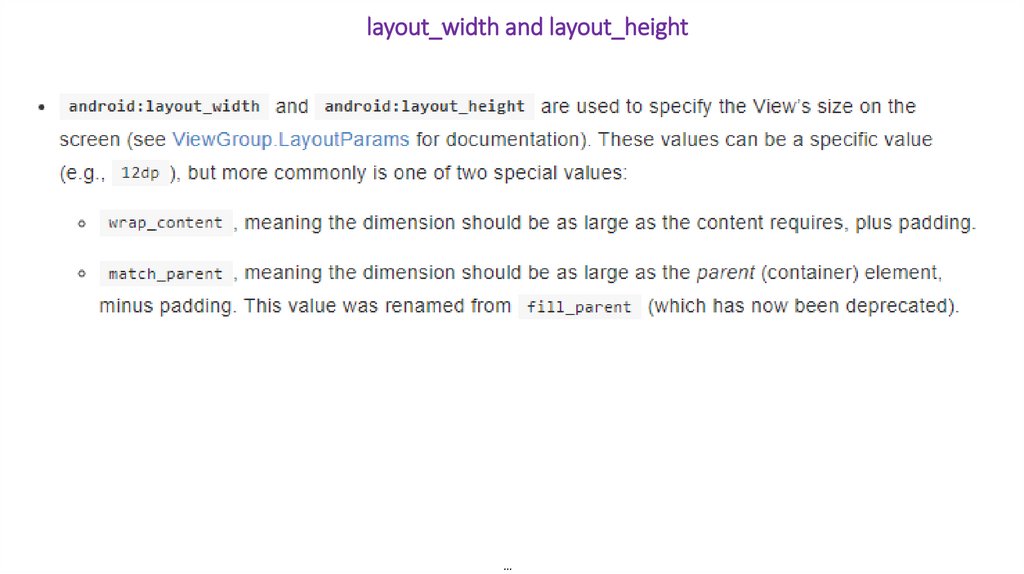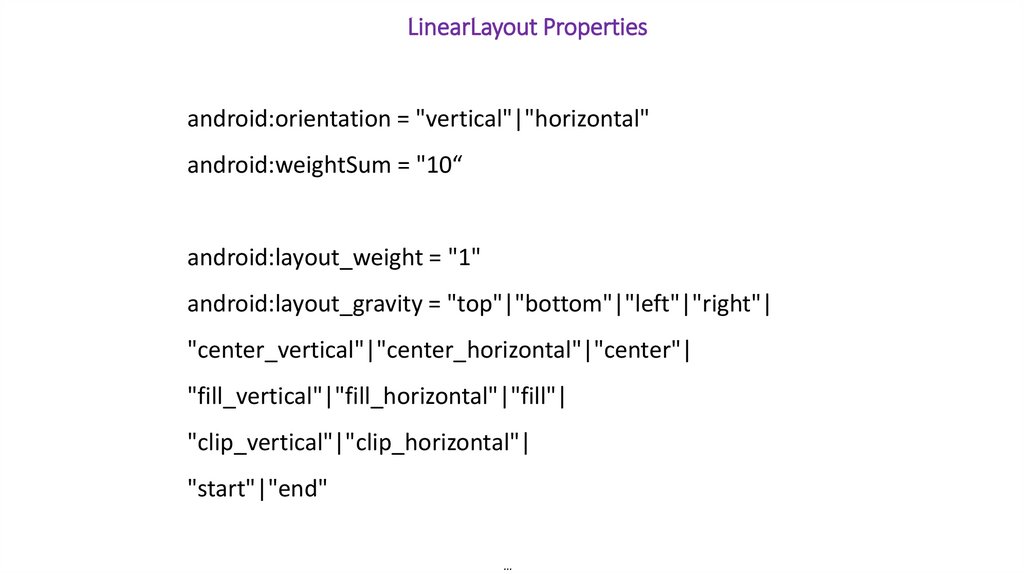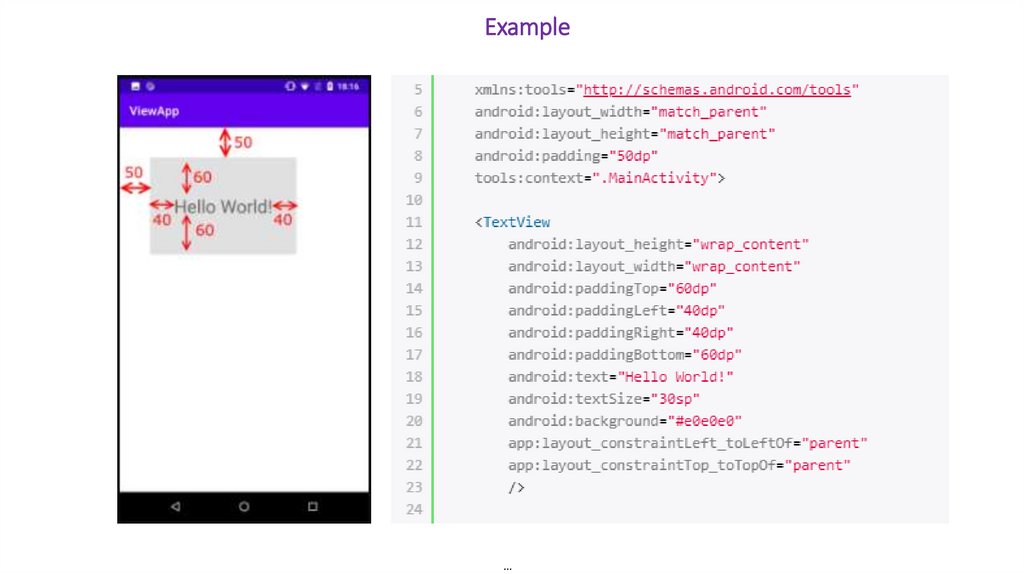Similar presentations:
Android Versions
1.
Android VersionsCode name
Version numbers
API level
Release date
No codename
1.0
1
September 23, 2008
No codename
1.1
2
February 9, 2009
Cupcake
1.5
3
April 27, 2009
Donut
1.6
4
September 15, 2009
Eclair
2.0 - 2.1
5-7
October 26, 2009
Froyo
2.2 - 2.2.3
8
May 20, 2010
Gingerbread
2.3 - 2.3.7
9 - 10
December 6, 2010
Honeycomb
3.0 - 3.2.6
11 - 13
February 22, 2011
Ice Cream Sandwich
4.0 - 4.0.4
14 - 15
October 18, 2011
Jelly Bean
4.1 - 4.3.1
16 - 18
July 9, 2012
KitKat
4.4 - 4.4.4
19 - 20
October 31, 2013
Lollipop
5.0 - 5.1.1
21- 22
November 12, 2014
Marshmallow
6.0 - 6.0.1
23
October 5, 2015
Nougat
7.0
24
August 22, 2016
Nougat
7.1.0 - 7.1.2
25
October 4, 2016
Oreo
8.0
26
August 21, 2017
Oreo
8.1
27
December 5, 2017
Pie
9.0
28
August 6, 2018
Android 10
10.0
29
September 3, 2019
Android 11
11
30
September 8, 2020
https://en.wikipedia.org/wiki/Android_version_history
2.
Android Architecturehttps://developer.android.com/guide/platform
3.
……
4.
…https://developer.android.com/guide/components/fundamentals
5.
……
6.
……
7.
……
8.
……
9.
Activity LifecycleMethod
Description
onCreate
called when activity is first created.
onStart
called when activity is becoming visible to the user.
onResume
called when activity will start interacting with the
user.
onPause
called when activity is not visible to the user.
onStop
called when activity is no longer visible to the user.
onRestart
called after your activity is stopped, prior to start.
onDestroy
called before the activity is destroyed.
https://developer.android.com/reference/android/app/Activity
10.
Log Methods…
11.
Resources Types…
12.
Resources TagsPath’s
res/values/strings.xml
res/values/strings.xml
res/values/strings.xml
res/values/arrays.xml
res/values/bools.xml
res/values/colors.xml
res/values/styles.xml
res/values/themes.xml
res/values/dimens.xml
res/values/ids.xml
res/values/integers.xml
res/values/integers.xml
res/color/
res/menu/
res/xml/
res/drawable/
res/drawable/
res/animator/
res/anim/
res/raw/
res/layout/
Tag’s
<plurals>
<string>
<string-array>
<string-array>
<bool>
<color>
<style>
<style>
<dimen>
<item>
<integer>
<integer-array>
<selector>
<menu>
<animation-list>
<set>, <objectAnimator>, <valueAnimator>
<set>, <alpha>, <rotate>, <scale>, <translate>
…
13.
LayoutsAn Android layout is a class that handles arranging the way its children appear on the screen. Anything
that is a View (or inherits from View) can be a child of a layout. All of the layouts inherit
from ViewGroup (which inherits from View) so you can nest layouts. You could also create your own
custom layout by making a class that inherits from ViewGroup.
…
14.
View Properties…
15.
layout_width and layout_height…
16.
Dimension Units…
17.
Dimension Units…
18.
View Classes…
19.
RelativeLayoutRelativeLayout is a view group that displays child views in
relative positions. The position of each view can be
specified as relative to sibling elements (such as to the
left-of or below another view) or in positions relative to the
parent RelativeLayout area (such as aligned to the
bottom, left or center).
…
20.
RelativeLayout Propertiesandroid:layout_above
android:layout_below
android:layout_toLeftOf
android:layout_toRightOf
android:layout_toStartOf
android:layout_toEndOf
android:layout_alignBottom
android:layout_alignLeft
android:layout_alignRight
android:layout_alignStart
android:layout_alignEnd
android:layout_alignTop
android:layout_alignBaseline
android:layout_alignParentBottom
android:layout_alignParentRight
android:layout_alignParentLeft
android:layout_alignParentStart
android:layout_alignParentEnd
android:layout_alignParentTop
android:layout_centerInParent
android:layout_centerHorizontal
android:layout_centerVertical
…
21.
LinearLayoutLinearLayout is a ViewGroup that arranges
the child View(s) in a single direction, either
vertically or horizontally.
…
22.
LinearLayout Propertiesandroid:orientation = "vertical"|"horizontal"
android:weightSum = "10“
android:layout_weight = "1"
android:layout_gravity = "top"|"bottom"|"left"|"right"|
"center_vertical"|"center_horizontal"|"center"|
"fill_vertical"|"fill_horizontal"|"fill"|
"clip_vertical"|"clip_horizontal"|
"start"|"end"
…
23.
FrameLayoutFrameLayout is a simple layout. It can
contain one or more child View(s), and
they can overlap each other.
Therefore,
the android:layout_gravity attribute is
used to locate the child View(s).
…
24.
android:layout_gravity…
25.
TableLayoutTableLayout arranges the View(s) in table format.
Specifically, TableLayout is a ViewGroup containing
one or more TableRow(s). Each TableRow is a row in
the table containing cells. Child View(s) can be placed in
one cell or in a merged cell from adjacent cells of a row.
Unlike tables in HTML, you cannot merge consecutive
cells in the one column.
…
26.
GridLayoutGridLayout uses a grid of infinitely-thin lines to
separate its drawing area into: rows, columns,
and cells. It supports both row and column
spanning, this means it is possible to merge
adjacent cells into a large cell (a rectangle) to
contain a View.
…
27.
Gravity and Layout_Gravityhttps://learntodroid.com/what-is-the-difference-between-gravity-and-layout_gravity-in-android/
28.
Padding…
29.
Margins…
30.
Example…
31.
ConstraintLayoutConstraintLayout – Introduced in Android 7, use of this layout manager is recommended for most layout
requirements. ConstraintLayout allows the positioning and behavior of the views in a layout to be defined
by simple constraint settings assigned to each child view. The flexibility of this layout allows complex layouts
to be quickly and easily created without the necessity to nest other layout types inside each other, resulting
in improved layout performance. ConstraintLayout is also tightly integrated into the Android Studio Layout
Editor tool. Unless otherwise stated, this is the layout of choice for the majority of examples in this book.
…
32.
ConstraintLayout…
33.
ConstraintLayout Propertiesapp:layout_constraintDimensionRatio="1:0.5"
app:layout_constraintHorizontal_bias="0.5"
app:layout_constraintVertical_bias="0.5"
app:layout_constraintWidth_default="percent"
app:layout_constraintWidth_percent="0.5"
app:layout_constraintHeight_default="percent"
app:layout_constraintHeight_percent="0.5"
app:layout_constraintHorizontal_chainStyle = "spread"|"spread_inside"|"packed"
app:layout_constraintHorizontal_weight = "1"
app:layout_constraintVertical_chainStyle = "spread"|"spread_inside"|"packed"
app:layout_constraintVertical_weight = "1"
…
34.
ConstraintLayout Properties2layout_constraintLeft_toLeftOf
layout_constraintLeft_toRightOf
layout_constraintRight_toLeftOf
layout_constraintRight_toRightOf
layout_constraintTop_toTopOf
layout_constraintTop_toBottomOf
layout_constraintBottom_toBottomOf
layout_constraintBottom_toTopOf
layout_constraintBaseline_toBaselineOf
layout_constraintStart_toEndOf
layout_constraintStart_toStartOf
layout_constraintEnd_toStartOf
layout_constraintEnd_toEndOf
…
35.
include…
36.
ConstraintLayout ChainStyle…
37.
Android ……
38.
Android ……






































 software
software








